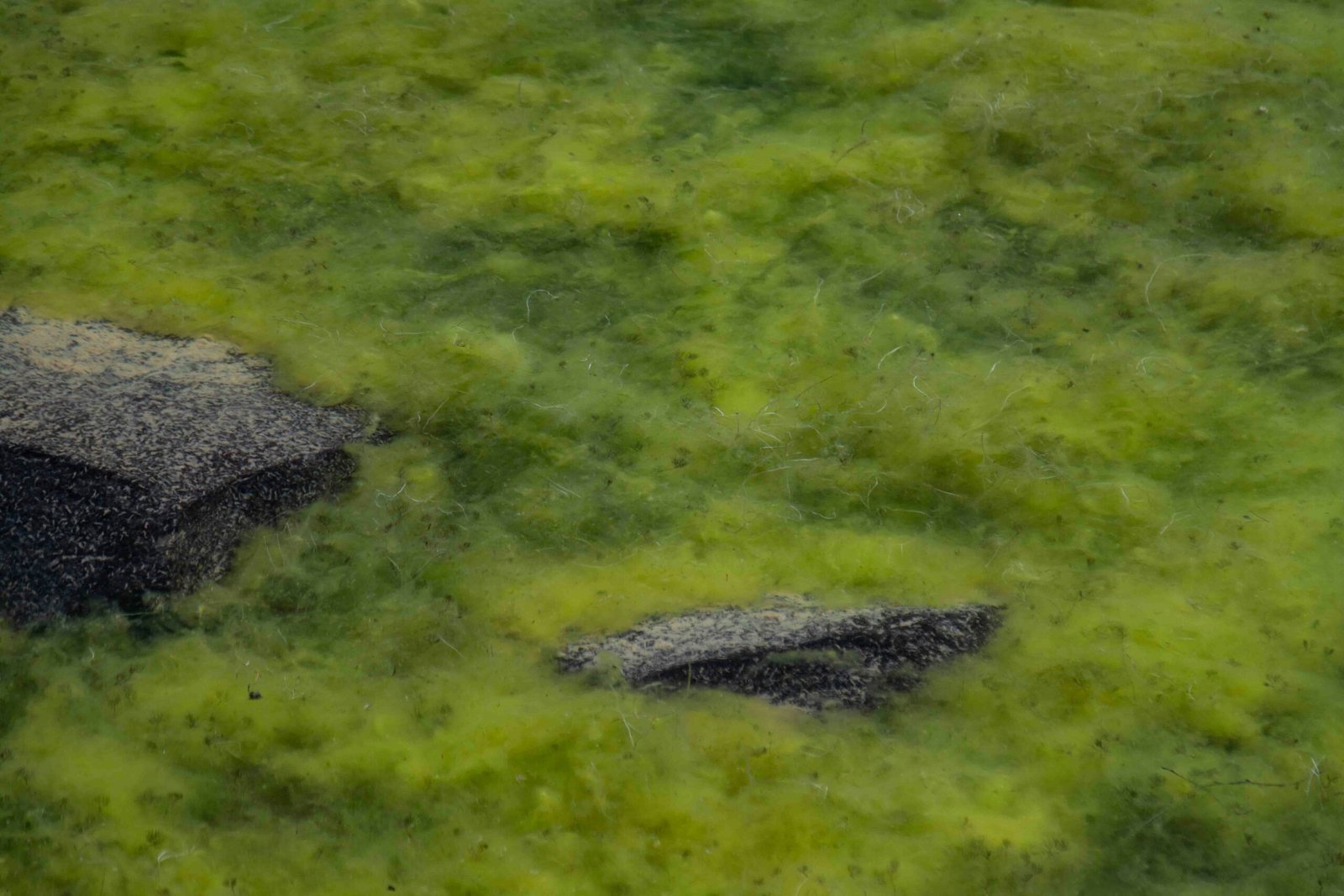Introduction to Algae
Algae constitute a diverse group of photosynthetic organisms found in various aquatic and terrestrial habitats, ranging from freshwater lakes and oceans to moist soils and tree bark. These organisms exhibit a great deal of variability in form, size, and structure, encompassing both microscopic varieties, known as microalgae, and larger, more complex forms, referred to as macroalgae.
Microalgae, which are typically unicellular, include species such as diatoms and dinoflagellates. These tiny algae play a crucial role in aquatic ecosystems, serving as primary producers at the base of the food web. They are instrumental in the global carbon cycle, contributing significantly to photosynthetic biomass production and oxygen generation.
Conversely, macroalgae, often called seaweeds, comprise multicellular species, including brown, green, and red algae. Commonly found in marine environments, macroalgae such as kelp can form extensive underwater forests that provide shelter and food for a multitude of marine organisms. Certain types of macroalgae are also harvested for their commercial value, particularly in the food, pharmaceutical, and cosmetic industries, where their nutritive and functional properties are highly prized.
Algae are categorized based on various criteria, including pigmentation, storage products, and cell wall composition. This classification helps distinguish different groups such as Chlorophyta (green algae), Rhodophyta (red algae), and Phaeophyceae (brown algae). Each group exhibits unique adaptations and structural characteristics, contributing to their ecological roles and distribution.
The significance of algae extends beyond their ecological contributions. They are pivotal in biotechnological applications, from biofuel production to wastewater treatment. As primary producers, they drive energy flow in ecosystems and aid in nutrient cycling. The study of algae offers insights into environmental health and potential solutions for sustainability challenges, underscoring their importance in both natural and human-modified environments.
Ecological Roles of Algae
Algae play a pivotal role in ecosystems, serving as the foundation for various ecological processes and supporting diverse forms of life. Notably, algae are critical primary producers, harnessing sunlight to carry out photosynthesis, a process that produces oxygen essential for the survival of aerobic organisms. These microscopic and macroscopic plants generate approximately 50% of the Earth’s oxygen supply, surpassing the contribution of terrestrial plants. By converting carbon dioxide into organic compounds, algae play a significant role in the global carbon cycle, aiding in the regulation of atmospheric carbon dioxide levels.
In addition to their role in oxygen production, algae form the basis of aquatic food webs. As primary producers, they generate biomass that feeds herbivorous organisms, which in turn support higher trophic levels, including fish and marine mammals. This position secures algae as an indispensable resource within aquatic ecosystems. Moreover, their substantial presence in oceans, freshwater bodies, and even terrestrial habitats ensures that they are integrated into a wide array of food chains.
Another critical ecological function of algae is their symbiotic relationships with other organisms. Lichens, for example, are a result of symbiosis between algae and fungi. The algae provide photosynthates, while the fungi offer structural support and protection. Coral reefs also benefit from the symbiotic relationship between corals and zooxanthellae, a type of dinoflagellate algae. The zooxanthellae supply energy to the corals via photosynthesis, facilitating reef growth and resilience.
Algae also contribute to habitat formation and maintenance. Kelp forests, primarily formed by brown algae, provide shelter and food for numerous marine species, creating complex underwater ecosystems. Similarly, algal mats stabilize sediments in aquatic environments, promoting habitat stability and reducing erosion. Through these diverse ecological roles, algae significantly influence the structure and functioning of ecosystems worldwide, underscoring their importance in maintaining environmental balance.
Habitat and Distribution
Algae, a diverse group of photosynthetic organisms, inhabit a wide range of environments across the globe. Primarily found in aquatic settings, algae flourish in both marine and freshwater ecosystems. In marine habitats, they are integral components of coastal and open ocean ecosystems. They contribute significantly to marine productivity, with certain species forming vast underwater forests and coral reefs. Light availability, nutrient concentration, and water motion are key abiotic factors influencing their distribution.
In freshwater ecosystems, algae occupy lakes, rivers, and ponds. They contribute to the primary productivity of these habitats, often forming blooms under nutrient-rich conditions. Temperature variations, light penetration, and nutrient levels are critical in determining the specific communities of algae in these water bodies. Freshwater algae are diverse, encompassing groups like diatoms, green algae, and cyanobacteria.
Beyond aquatic environments, algae are also present in terrestrial ecosystems. On land, they are typically found in moist soils, bark of trees, and even in symbiotic relationships with fungi, forming lichens. Extremophilic algae, adapted to survive in harsh and inhospitable environments, can be observed in areas such as deserts, hot springs, and polar ice caps. These extremophiles exhibit remarkable adaptations to cope with extreme temperatures, desiccation, and high levels of ultraviolet radiation.
Particular biogeographic patterns characterize the spread of algae. For instance, certain species are endemic to specific regions due to historical climatic and geological processes. Examples include the endemic red algae in the Mediterranean or unique green algae adaptations in the mighty Amazon River basin. The distribution closely mirrors local abiotic conditions, such as nutrient availability and light intensity, underscoring the profound influence of environmental factors on algae’s ecological presence.
Overall, the variety of habitats and biogeographic patterns of algae illustrate their ecological versatility and adaptability to a wide spectrum of environmental conditions. By thriving in diverse ecosystems, algae play an essential role in global ecological balance and nutrient cycles.
Thallus Organization in Algae
In the study of algal biology, thallus organization is a crucial aspect as it delineates the architectural framework of these organisms. The term ‘thallus’ refers to the body of algae, devoid of true stems, roots, or leaves, yet displaying a remarkable diversity in structure across various algal groups. This diversity ranges from the simplest unicellular forms to complex multicellular organisms, each uniquely adapted to their habitat.
Unicellular algae, such as Chlorella, represent the most basic organizational form, wherein a single cell performs all physiological functions. These algae dominate in environments where rapid reproduction and efficient nutrient uptake are essential for survival. On the other hand, colonial and filamentous forms exhibit a slightly more intricate organization, where multiple cells form loose colonies or unbranched chains, providing advantages such as enhanced buoyancy and protection against grazers.
Advancing in complexity, we encounter the siphonous organization seen in some green algae like Caulerpa, where multiple nuclei share a common cytoplasm. This unique structure allows for extensive growth and regeneration, advantageous in rapidly changing environments. Multicellular algae, such as the kelp species, demonstrate the pinnacle of thallus organization with differentiated tissues and specialized structures like holdfasts, stipes, and blades. These features provide stability, maximize light capture, and enhance nutrient absorption, thereby supporting their role as key players in marine ecosystems.
The thallus organization significantly influences the function and adaptability of algae in diverse environments. For example, the simple structure of unicellular algae allows them to thrive in nutrient-poor waters by maximizing their surface-to-volume ratio for optimal nutrient uptake. In contrast, complex multicellular algae can exploit various ecological niches, from intertidal zones to deep sea regions, by developing specialized structures for attachment, light acquisition, and reproduction.
Understanding the thallus organization in algae not only sheds light on their evolutionary strategies but also underscores their importance in ecological balance and biotechnological applications. The diversity in their structural forms reflects their adaptability and resilience, enabling them to occupy a wide range of habitats globally.
Morphological Diversity of Algae
The morphological diversity of algae is extensive, ranging from microscopic unicellular forms to large macroscopic colonies. Algae can be found in a multitude of structural manifestations, each adapted to their specific environmental niches. One prominent morphological type is the filamentous form, characterized by chain-like formations of cells linked end to end. These filaments can be simple strings of identical cells or more complex structures with specialized cells for functions such as reproduction and attachment.
Another notable form is the colonial algae, where individual cells congregate to function as a single entity. These colonies can take on various shapes, including spherical (as seen in green algae like Volvox) or irregular clusters. The aggregative nature of colonial algae allows them to enhance their survival and growth rates by offering mutual protection and increased resource acquisition capabilities.
Parenchymatous algae, on the other hand, exhibit more complex multicellular organization resembling that of higher plants. Unlike filamentous or colonial forms, parenchymatous algae possess differentiated tissues and often exhibit true differentiation of form and function among their cells. This type of algae is exemplified by seaweeds like kelps, which can grow to impressive sizes and possess specialized structures such as holdfasts for anchoring to substrates, blades for photosynthesis, and air bladders for buoyancy.
A remarkable aspect of algal morphological diversity is the presence of specialized cells and structural adaptations that enable them to thrive in their respective environments. For instance, some algae have developed heterocysts, which are specialized for nitrogen fixation, allowing them to inhabit nutrient-limited waters. Another adaptation is the formation of complex reproductive structures that help ensure the propagation of the species under varying environmental conditions.
In essence, the morphological diversity of algae showcases their evolutionary ingenuity, enabling them to colonize an array of habitats and optimize their survival strategies. From simple filaments to complex parenchymatous structures, algae reveal an extraordinary range of forms, each finely tuned to their ecological niches.
Reproduction and Life Cycles
Algae exhibit remarkable diversity in their reproductive strategies, encompassing both s and reproductive modes. These methods enable them to thrive in a myriad of aquatic and terrestrial environments. Reproduction is the simpler of the two strategies and occurs through processes such as binary fission, fragmentation, and spore formation. Binary fission involves the division of a single algal cell into two identical daughter cells, commonly observed in unicellular algae like Chlamydomonas. Fragmentation, seen in filamentous algae like Spirogyra, involves breaking off a piece of the algal thallus, which then grows into a new organism. Spore formation, which includes the production of motile zoospores or non-motile aplanospores, is another prolific method for rapid population expansion.
Reproduction in algae is more complex and involves the fusion of gametes. This genetic exchange enhances variability and adaptability. The life cycles of algae are diverse and can be classified into three primary categories: haplontic, diplontic, and haplodiplontic cycles. In haplontic life cycles, the dominant phase is haploid, as seen in many green algae like Ulothrix. Here, the only diploid stage is the zygote, which undergoes meiosis to produce haploid spores.
Diplontic life cycles, on the other hand, feature a predominantly diploid phase. This type is less common in algae but is exemplified by some members of the brown algae, such as Fucus, where the organism spends most of its life in the diploid state, and gametes are the only haploid cells.
The haplodiplontic life cycle, also known as alternation of generations, involves both haploid and diploid multi-cellular stages. This is observed in algae like the green alga Ulva and many red algae. In these cases, both the gametophyte (haploid) and the sporophyte (diploid) generations are conspicuous and can exist independently, contributing to a more intricate lifecycle.
Understanding the reproductive strategies and life cycles of algae not only highlights their ecological versatility but also underscores their evolutionary adaptability. This knowledge is crucial for appreciating the complex dynamics of aquatic ecosystems where algae play fundamental roles.
Human Uses and Impacts
Algae have long been esteemed for their manifold utilities, spanning considerable breadths from alimentation to advanced technological applications. Their presence in the food sector is pronounced, particularly in Asian cuisines where varieties such as nori, agar, and spirulina are dietary staples. Beyond traditional culinary uses, algae are progressively being harnessed as sustainable food sources due to their high nutritional value, rich in proteins, vitamins, and essential fatty acids. Spirulina, in particular, has gained notoriety as a superfood, boasting a robust profile of nutrients that promote overall health.
In agriculture, algae serve as potent biofertilizers and soil conditioners, augmenting soil health and enhancing crop yields naturally. The extract of certain algae synthesizes into biostimulants, optimizing plant growth and resilience. Furthermore, advancements in biochemical methods have allowed for the development of algae-based biofuels. Given the growing concerns over fossil fuel dependence and environmental conservation, the transition to biofuel presents a greener alternative, with microalgae touted for their ability to convert sunlight into energy efficiently.
Medicinally, algae offer a treasure trove of bioactive compounds that exhibit therapeutic potential. Research investigates their applications in novel antibiotics, antivirals, and anti-inflammatory agents, pushing the frontiers of pharmaceutical innovation. Certain algae-derived substances, such as carotenoids and polyunsaturated fatty acids, also play pivotal roles in nutraceuticals, contributing to the maintenance of human health.
Nevertheless, the influence of algae on the environment is not exclusively beneficial. Harmful algal blooms (HABs), characterized by the explosive proliferation of toxic algae, pose significant threats to aquatic ecosystems. These blooms can disrupt water quality, endanger aquatic life, and impair fisheries and recreational water use. Mitigation of HABs remains a crucial area of environmental management.
On a positive note, algae’s role in bioremediation showcases their capability in cleansing polluted environments. Alga-based methodologies have been effective in mitigating contaminants such as heavy metals and nitrogenous compounds from water bodies, highlighting their potential in restoration ecology. This bioremediation process leverages algae’s natural metabolic pathways to absorb and neutralize pollutants, thereby enhancing the health of the ecosystem.
Future Research and Challenges
The field of algae research is continuously evolving, influenced by current environmental trends and technological advancements. A significant focus is being placed on understanding the ecological impacts of climate change on algal populations, as shifting temperature and pH levels in marine and freshwater ecosystems can drastically affect their growth and distribution. Researchers are also examining how pollution, specifically chemical pollutants and microplastics, disrupt algal communities and their associated food webs. The overexploitation of algal resources, owing to their potential in biofuel production, pharmaceuticals, and food supplements, is another pressing concern that calls for meticulous resource management and conservation strategies.
Emerging technologies are playing a pivotal role in the advancement of algae research. Metagenomics and high-throughput sequencing are revolutionizing our understanding of algal biodiversity and their genetic adaptations to environmental changes. Additionally, techniques such as CRISPR-Cas9 gene editing are being explored to enhance algal strains for higher efficiency in biofuel production and other commercial applications. Remote sensing and satellite imaging offer unprecedented insights into large-scale algal blooms and their ecological impacts, enabling more accurate monitoring and prediction models.
Despite these technological strides, several challenges remain. Efficient sustainable management of algal resources demands an integrated approach that combines ecological, socio-economic, and technological perspectives. Developing policies that mitigate the adverse effects of climate change and pollution, while promoting the responsible use of algal resources, is vital. Furthermore, fostering international collaboration and cross-disciplinary research will be essential in addressing the complex issues facing algae ecosystems. Through concerted efforts and innovative solutions, the scientific community aims to mitigate these challenges, ensuring the sustainable exploitation and conservation of algal resources for future generations.
























+ There are no comments
Add yours